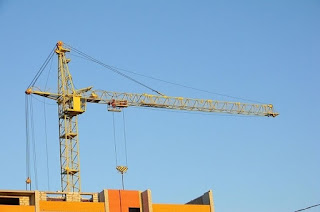Take
Care of Cranes and MHE in Different Temperatures
You have a thriving
construction business. You and your bodacious team has a reservoir of ideas for
various projects. Your construction and material handling equipment are ready
to carve out the best building. However, you see that your reliable, foolproof
equipment have hung you out to dry!
Reason - searing summer heat or
frosting winter cold.
Varying temperatures can drastically
impact your machines' performance. It is imperative to understand why and how
you should take care of cranes and sundry other construction equipage. But before
I gen you up on this, let's look at SGF Fab.
Monorail
manufacturers SGF Fab provide heatingoven fabrication in Bangalore. This one-off company is transmogrifying the
flourishing construction industry with their flawless services and foolproof
equipment. They are also one of the best single
girder crane manufacturers in Bangalore.
Image Credit - weSRCH
They provide a slew of
implements like H.O.T. cranes, single/double girder EOT, single/double girder
gantry, jib cranes and a lot more. These transfer
trolley manufacturers in India
afford spiffing pieces of equipment that hasten any construction process. You
can choose an implement depending on the work/action to be undertaken. SGF Fab
don't impose their catalogue on customers. These incredible precast handling crane manufacturers provide tailor-made clobber too.
If you are looking for reliable
fabrication equipage, SGF Fab are an unfailing option.
The following points on the
impact of temperatures on cranes and MHE were perceptively explained by
American Crane. I hope you find them useful.
Incorporate
These Strategies/Tools
·
Severe-duty
motors with special insulation, fungal protection, and sealed bearings
·
Motor
strip heaters, stainless steel breather plugs, and corrosion-resistant hardware
·
Proper
lubricant selection, based on temperature extremes inherent in the application
at hand
·
Sealed
cable glands
·
Stainless
steel hoist wire rope for corrosion resistance
·
Three-part
painting system for the trolley frame, as follows:
v Surface preparation: SSPCSP10, near-white metal blast
v First coat: Inorganic zinc
primer (2-3 mils)
v Second coat: Epoxy
intermediate coat (4-6 mils)
v Topcoat: Polyurethane finish
coat (3-5 mils)
Conductor systems must also
be considered when dealing with outdoor service applications, and UV-resistant
covers and corrosion-resistant hardware should be employed. Also, keep in mind
that hoist operations must typically be curtailed when wind speeds exceed 35
mph.
Incorporating the features
above will allow for a much more resilient material handling system. When
deciding on a hoist, crane, or component for a particular outdoor application,
it’s imperative to carefully consider each piece of equipment before making a
final decision; otherwise, operations, workers, and the surrounding environment
are all in danger. Totally avoid ill-suited clobber to stave off accidents and damage.
Cold Temperatures and MHE
When weighing different hoist
options, consider choosing equipment that meets the American Society of Mechanical Engineers’ (ASME’s) temperature standards for proper hoist
operation. These standards provide a temperature range for optimal equipment
operation, and can be hugely useful in guiding industry professionals toward
the best solutions for their specific jobs. Below are three relevant ASME
standards for outdoor crane applications.
·
ASME Standard for Manually Operated Chain Hoists — Hoists and trolleys covered
by this standard are intended for industrial use in ambient temperatures from 0
°F to 130 °F.
·
ASME Standard for Electric Chain Hoists — Hoist equipment is
designed to operate in ambient temperatures between 0 °F and 104 °F.
·
ASME for Below the Hook Lifting Devices — Additional considerations
need to be taken into account if the working temperature is outside the range
of 24 °F to 150 °F.
Impact
of Cold Temperatures on Steel
Cold temperatures can have a
serious impact on steel, in turn affecting the working capacity of material
handling cranes. When exposed to extreme cold, the structure of steel can shift
significantly, going from ductile to brittle as conditions become colder and
reach the ductile-to-brittle-transition temperature (DBTT). This shift in
structure can have a catastrophic, unpredictable impact on cranes and hoist
equipment, greatly affecting their performance. While functionality failure
caused by cold weather can occur randomly, it can also be a side effect of
other stressors, such as cracks and nicks.
(Inputs from American Crane)

Comments
Post a Comment